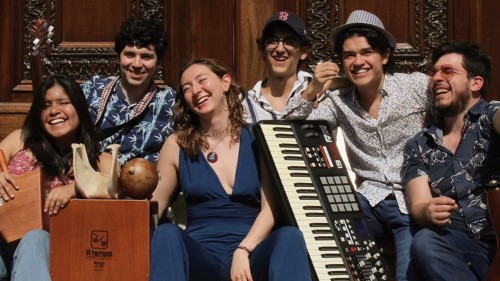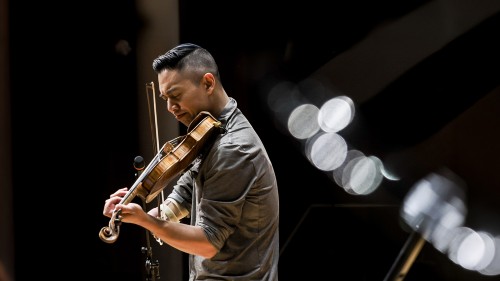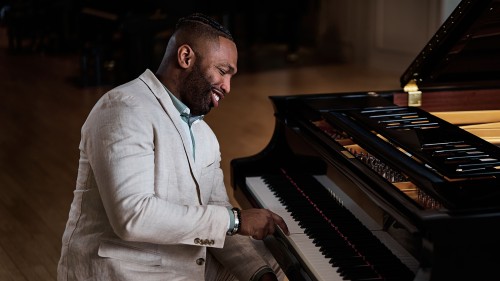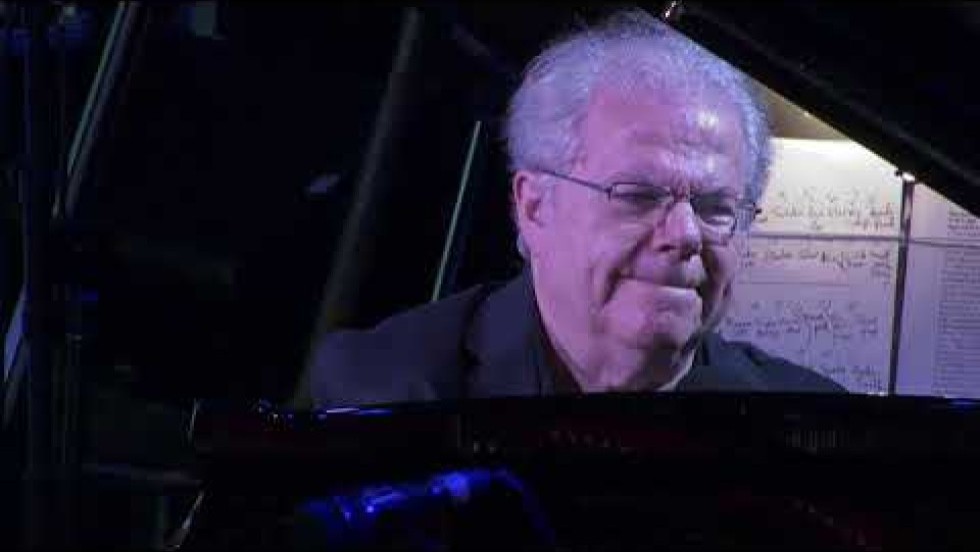
Emanuel Ax, piano
Fantasies
at Groton Hill Music Center's Concert Hall (Groton, MA)
Cookie Notice
This site uses cookies to measure our traffic and improve your experience. By clicking "OK" you consent to our use of cookies.
Celebrity Series audiences love Emanuel Ax! After more than 30 appearances on the Series, he always impresses with his impeccable skill at putting the music first.
The two sonatas of Beethoven’s Opus 27, rarely heard together, throw the form’s rules aside: tempo, structure, and flow are at the composer’s whim. Ax pairs these sonatas with selections from Schoenberg's fascinating keyboard repertoire. In a review of a similar program, SeenAndHeard International praised the pairing:
"Through Ax’s masterful interpretation, Schoenberg’s atonal landscapes revealed their hidden Romantic heart, while Beethoven’s sonatas, especially the Op.2, No.2, showcased the composer’s revolutionary spirit."
Ax concludes his program with Schumann's virtuosic early Romantic showpiece Fantasie in C Major, dedicated to Liszt, published to raise funds for a statue of Beethoven in Bonn, and written—in part—as a love letter to the brilliant young pianist Clara Wieck. With this constellation of inspiration, how could the piece be anything other than a celebration of artistry, passion, and unbridled expression?
Hear a master of his craft uncover unexpected connections and share moments of beauty when Emanuel Ax returns to Celebrity Series.
Program Details
Fantasies
"We have one set of expectations of a “fantasy,” another of a “sonata” … We are satisfied if a second-rate talent shows that [they have] mastered the traditional range of forms, whereas with a first-rate talent we allow that [they] expand that range. Only a genius may reign freely."
—Robert Schumann
Emanuel Ax's program explores the keyboard fantasy in works by Beethoven, Schoenberg, and Schumann. Each invokes the expressiveness, freedom, and improvisatory spirit embodied in the genre. As compositional style evolved to provide less room for true improvisation, the fantasy became increasingly bound to the notes on the page. Despite the strictures of notation, this malleable genre, perhaps more than any other, reveals the fantasy and skill of the author who created it.
—Andrew McIntyre, program annotator
"We have one set of expectations of a “fantasy,” another of a “sonata” … We are satisfied if a second-rate talent shows that [they have] mastered the traditional range of forms, whereas with a first-rate talent we allow that [they] expand that range. Only a genius may reign freely."
—Robert Schumann
Emanuel Ax's program explores the keyboard fantasy in works by Beethoven, Schoenberg, and Schumann. Each invokes the expressiveness, freedom, and improvisatory spirit embodied in the genre. As compositional style evolved to provide less room for true improvisation, the fantasy became increasingly bound to the notes on the page. Despite the strictures of notation, this malleable genre, perhaps more than any other, reveals the fantasy and skill of the author who created it.
—Andrew McIntyre, program annotator
Among the 135 works published in Beethoven’s lifetime, thirty-two are piano sonatas. He composed the first twenty sonatas in an eight-year period beginning in 1795. Many of these show a deference to Classical traditions, yet Beethoven soon grew frustrated within these strictures. In a statement made to Carl Czerny, one of his students, he mused, “I am only somewhat satisfied with my previous works. From today on I will take a new path.”
Steps upon this path appear in Opus 27, a pair of groundbreaking sonatas completed in 1801. Both are subtitled “Quasi una fantasia;” this invocation of the fantasy is the first time the term was associated with such dramatically unified, multi-movement works. Those who witnessed Beethoven’s keyboard improvisations wrote of their intensely moving nature. A contemporary described one such performance as a “deeply expressive portrait of [Beethoven’s] soul.” In synthesizing form and fantasy, Beethoven tempered profound, improvised musical utterances within the confines of relatively familiar structures.
Unlike a typical sonata, all of the movements in both are played without pause. In contrast to earlier sonatas, which present their weightiest movement first, here Beethoven saves the climactic movements for the finales (a structure he would revisit most notably in the choral finale of his Ninth Symphony). Musicologist Jürgen Uhde saw these sonatas as standing at the crossroads of Enlightenment optimism and the emerging pessimism of the Romantic period.
The E-flat major sonata opens with a hybrid rondo in an ABACA pattern. The A section consists of a simple melody with a short-short-long rhythm and conventional harmonies; with each repetition, Beethoven introduces subtle changes of character and voicing. The B section shares this rhythm but blooms into ornate, animated passages. Beethoven’s impetuousness erupts in the virtuosic C section, a toccata, before a return of the opening material and a coda.
Beethoven builds the second movement scherzo on a descending bass line. Often used to convey sorrow, its most famous Baroque expression is the “lament bass” of “When I am laid in earth” from Purcell’s Dido and Aeneas. The trio, with its galloping rhythm and a knowingly self-important trill, is more humorous. A return of the scherzo section, now with right-hand syncopation, concludes with a fortissimo outburst.
The slow third movement is built upon a stately, lyrical melody in three strands. A grandiose flourish in the final bars leads directly into a raucous finale. Strands of melody from the Adagio return in various guises as Beethoven develops and transforms them. Unexpected shifts in tempo, dynamic, and texture create an impression of dancers spiraling out of control. Despite half-hearted attempts at restraint, the sonata concludes with irrepressible fanfare.
© Andrew McIntyre, 2024
Among the 135 works published in Beethoven’s lifetime, thirty-two are piano sonatas. He composed the first twenty sonatas in an eight-year period beginning in 1795. Many of these show a deference to Classical traditions, yet Beethoven soon grew frustrated within these strictures. In a statement made to Carl Czerny, one of his students, he mused, “I am only somewhat satisfied with my previous works. From today on I will take a new path.”
Steps upon this path appear in Opus 27, a pair of groundbreaking sonatas completed in 1801. Both are subtitled “Quasi una fantasia;” this invocation of the fantasy is the first time the term was associated with such dramatically unified, multi-movement works. Those who witnessed Beethoven’s keyboard improvisations wrote of their intensely moving nature. A contemporary described one such performance as a “deeply expressive portrait of [Beethoven’s] soul.” In synthesizing form and fantasy, Beethoven tempered profound, improvised musical utterances within the confines of relatively familiar structures.
Unlike a typical sonata, all of the movements in both are played without pause. In contrast to earlier sonatas, which present their weightiest movement first, here Beethoven saves the climactic movements for the finales (a structure he would revisit most notably in the choral finale of his Ninth Symphony). Musicologist Jürgen Uhde saw these sonatas as standing at the crossroads of Enlightenment optimism and the emerging pessimism of the Romantic period.
The E-flat major sonata opens with a hybrid rondo in an ABACA pattern. The A section consists of a simple melody with a short-short-long rhythm and conventional harmonies; with each repetition, Beethoven introduces subtle changes of character and voicing. The B section shares this rhythm but blooms into ornate, animated passages. Beethoven’s impetuousness erupts in the virtuosic C section, a toccata, before a return of the opening material and a coda.
Beethoven builds the second movement scherzo on a descending bass line. Often used to convey sorrow, its most famous Baroque expression is the “lament bass” of “When I am laid in earth” from Purcell’s Dido and Aeneas. The trio, with its galloping rhythm and a knowingly self-important trill, is more humorous. A return of the scherzo section, now with right-hand syncopation, concludes with a fortissimo outburst.
The slow third movement is built upon a stately, lyrical melody in three strands. A grandiose flourish in the final bars leads directly into a raucous finale. Strands of melody from the Adagio return in various guises as Beethoven develops and transforms them. Unexpected shifts in tempo, dynamic, and texture create an impression of dancers spiraling out of control. Despite half-hearted attempts at restraint, the sonata concludes with irrepressible fanfare.
© Andrew McIntyre, 2024
Like another Viennese composer a century earlier, Schoenberg set off to find “new paths” in his musical output. Yet while Beethoven’s stylistic evolution was partially borne of his hearing loss, Schoenberg’s came about in the wake of another sort of crisis. His wife, Mathilde, had begun a messy affair with one of Schoenberg’s close friends, a young painter named Richard Gerstl. Following a brief elopement Mathilde returned to Schoenberg and their two young children; soon after, Gerstl took his own life. Schoenberg, in a letter mirroring Beethoven’s famed Heiligenstadt Testament, hinted at suicide, writing that he had “plunged from one madness into another.”
Schoenberg completed several compositions in the wake of the affair, all of them moving further away from traditional harmonic practice. His String Quartet No. 2, premiered shortly after Gerstl’s suicide in autumn of 1908, abandoned tonality in its final movement. In the finale, a soprano sings the prophetic line “I feel air from another planet” amidst amorphous string harmonies. Schoenberg continued his exploration of atonality (he preferred the term “pantonality”) in the subsequent compositions of 1909, including his monodrama Erwartung and the Three Piano Pieces, Op. 11.
Predominantly elegiac and bristling with nervous energy, the mood of the first piece reflects Schoenberg’s anguish at his wife and friend’s betrayal. Capricious, virtuosic flourishes evoke the spirit of the fantasia.
In a letter to Richard Strauss, Schoenberg described another work from this period as “without architecture, without structure. Only an ever-changing, unbroken succession of colors, rhythms, and moods.” (Strauss privately told Alma Mahler that Schoenberg needed therapy.) Though he sought “complete liberation from all forms,” Schoenberg creates unity through both form and gesture in the slow second piece. The low pedal tones and oscillations that obsessively haunt the opening return at its conclusion.
The trio concludes in explosive turmoil. Clangorous and quasi-improvisatory, this last piece most closely approaches an extemporaneous sense of fantasy. After a series of thunderous outbursts, the set ends with hushed, uncertain wisps of harmony.
© 2024 Andrew McIntyre
Like another Viennese composer a century earlier, Schoenberg set off to find “new paths” in his musical output. Yet while Beethoven’s stylistic evolution was partially borne of his hearing loss, Schoenberg’s came about in the wake of another sort of crisis. His wife, Mathilde, had begun a messy affair with one of Schoenberg’s close friends, a young painter named Richard Gerstl. Following a brief elopement Mathilde returned to Schoenberg and their two young children; soon after, Gerstl took his own life. Schoenberg, in a letter mirroring Beethoven’s famed Heiligenstadt Testament, hinted at suicide, writing that he had “plunged from one madness into another.”
Schoenberg completed several compositions in the wake of the affair, all of them moving further away from traditional harmonic practice. His String Quartet No. 2, premiered shortly after Gerstl’s suicide in autumn of 1908, abandoned tonality in its final movement. In the finale, a soprano sings the prophetic line “I feel air from another planet” amidst amorphous string harmonies. Schoenberg continued his exploration of atonality (he preferred the term “pantonality”) in the subsequent compositions of 1909, including his monodrama Erwartung and the Three Piano Pieces, Op. 11.
Predominantly elegiac and bristling with nervous energy, the mood of the first piece reflects Schoenberg’s anguish at his wife and friend’s betrayal. Capricious, virtuosic flourishes evoke the spirit of the fantasia.
In a letter to Richard Strauss, Schoenberg described another work from this period as “without architecture, without structure. Only an ever-changing, unbroken succession of colors, rhythms, and moods.” (Strauss privately told Alma Mahler that Schoenberg needed therapy.) Though he sought “complete liberation from all forms,” Schoenberg creates unity through both form and gesture in the slow second piece. The low pedal tones and oscillations that obsessively haunt the opening return at its conclusion.
The trio concludes in explosive turmoil. Clangorous and quasi-improvisatory, this last piece most closely approaches an extemporaneous sense of fantasy. After a series of thunderous outbursts, the set ends with hushed, uncertain wisps of harmony.
© 2024 Andrew McIntyre
The C-sharp minor sonata has long overshadowed its sunnier twin. One contemporary of Beethoven’s gave polite praise to the first; the second, however, he deemed “beyond reproach.” “This fantasy,” he continued, “is from beginning to end a sterling whole, at once sprung from the whole of a deep and ardent imagination, and at the same time hewn from a block of marble.”
The sonata’s popularity was such that Beethoven himself is said to have tired of it. “Surely I’ve written better things,” he complained. “Why does everybody play it?” Perhaps it’s best that the nickname, from a comparison of the first movement to “the wild places on Lake Lucerne by moonlight,” came into fashion after Beethoven’s death.
Beethoven draws on tropes of mourning in the first movement. The dotted rhythm evokes church bells and funeral marches (this rhythm also permeates the Marche funèbre of the Eroica Symphony, which was germinating as he composed these sonatas), and the melodic contour mimics liturgical chant over a descending lament bass. Rich chromaticism and a wandering right-hand melody in the movement’s middle allude to the fantasy’s unrehearsed spirit while foregoing virtuosity.
A succinct and cheerful minuet and trio link the outer movements. Franz Liszt supposedly referred to it as “a flower between two chasms.”
Like the preceding movements, most of the finale is played piano, but its rushing tempo and violent outbursts give this music an astounding ferocity. If Beethoven’s improvisations were indeed “portraits of the soul,” then it is tempting to link this fantasia to the anger and despair he felt over his deafness. Following this narrative arc, the sonata ends with bold fortissimo chords as pessimism gives way to defiance.
© Andrew McIntyre, 2024
The C-sharp minor sonata has long overshadowed its sunnier twin. One contemporary of Beethoven’s gave polite praise to the first; the second, however, he deemed “beyond reproach.” “This fantasy,” he continued, “is from beginning to end a sterling whole, at once sprung from the whole of a deep and ardent imagination, and at the same time hewn from a block of marble.”
The sonata’s popularity was such that Beethoven himself is said to have tired of it. “Surely I’ve written better things,” he complained. “Why does everybody play it?” Perhaps it’s best that the nickname, from a comparison of the first movement to “the wild places on Lake Lucerne by moonlight,” came into fashion after Beethoven’s death.
Beethoven draws on tropes of mourning in the first movement. The dotted rhythm evokes church bells and funeral marches (this rhythm also permeates the Marche funèbre of the Eroica Symphony, which was germinating as he composed these sonatas), and the melodic contour mimics liturgical chant over a descending lament bass. Rich chromaticism and a wandering right-hand melody in the movement’s middle allude to the fantasy’s unrehearsed spirit while foregoing virtuosity.
A succinct and cheerful minuet and trio link the outer movements. Franz Liszt supposedly referred to it as “a flower between two chasms.”
Like the preceding movements, most of the finale is played piano, but its rushing tempo and violent outbursts give this music an astounding ferocity. If Beethoven’s improvisations were indeed “portraits of the soul,” then it is tempting to link this fantasia to the anger and despair he felt over his deafness. Following this narrative arc, the sonata ends with bold fortissimo chords as pessimism gives way to defiance.
© Andrew McIntyre, 2024
After Mathilde ended the affair, she and Arnold reconciled. However, Schoenberg found it difficult to secure work in Vienna, leaving the family so poor that their daughter Gertrud became anemic and malnourished. Partly to find better employment, partly to escape anti-Semitic harassment by neighbors, the Schoenbergs returned to Berlin in 1911.
Earlier that year, Schoenberg had completed his Opus 19, a collection of six piano miniatures. Their extreme brevity—No. 1, the longest, is only eighteen bars long—expresses what Schoenberg called the “creative instant of inspiration.” (What better phrase to encapsulate the spirit of the fantasia?) In a letter to the painter Wassily Kandinsky, he proclaimed, “Art belongs to the unconscious! One must express oneself! Express oneself directly!” Schoenberg saw the truest expression of the psyche in concise, unedited artistic creativity, “not built but expressed.”
Schoenberg composed the first five pieces in a single day. While these are somewhat united in character and content—the staccato dyad introduced in No. 2 appears in subsequent movements—each is its own thought encapsulated in sound. Schoenberg wrote the sixth and final movement in the wake of the death of his friend Gustav Mahler. It consists of a slow alternation of two chords like the melancholy tolling of distant bells.
© 2024 Andrew McIntyre
After Mathilde ended the affair, she and Arnold reconciled. However, Schoenberg found it difficult to secure work in Vienna, leaving the family so poor that their daughter Gertrud became anemic and malnourished. Partly to find better employment, partly to escape anti-Semitic harassment by neighbors, the Schoenbergs returned to Berlin in 1911.
Earlier that year, Schoenberg had completed his Opus 19, a collection of six piano miniatures. Their extreme brevity—No. 1, the longest, is only eighteen bars long—expresses what Schoenberg called the “creative instant of inspiration.” (What better phrase to encapsulate the spirit of the fantasia?) In a letter to the painter Wassily Kandinsky, he proclaimed, “Art belongs to the unconscious! One must express oneself! Express oneself directly!” Schoenberg saw the truest expression of the psyche in concise, unedited artistic creativity, “not built but expressed.”
Schoenberg composed the first five pieces in a single day. While these are somewhat united in character and content—the staccato dyad introduced in No. 2 appears in subsequent movements—each is its own thought encapsulated in sound. Schoenberg wrote the sixth and final movement in the wake of the death of his friend Gustav Mahler. It consists of a slow alternation of two chords like the melancholy tolling of distant bells.
© 2024 Andrew McIntyre
The year 1836 ushered in one of the fiercest crises of Schumann’s life: the rejection of his marriage proposal to Clara Weick. Clara’s father Friedrich, who had also been Schumann’s piano teacher, saw their relationship as a threat to Clara’s concert career and vehemently opposed the engagement, even threatening to shoot his future son-in-law. Schumann, distraught at the opposition from Clara’s father, attempted to purge her from his thoughts. This annus horribilis—Schumann himself dubbed 1836 his “sad year”—brought forth a flood of compositions, many inspired by Clara. Perhaps the most striking of these is the Fantasie we hear today.
“In order to understand the Fantasie,” he later told Clara, “you will have to transport yourself into the unhappy summer of 1836, when I renounced you.” Schumann composed the first movement as a stand-alone rumination. However, upon learning of plans to erect a monument to Beethoven in his hometown of Bonn, Schumann aimed to write a piece to raise funds for its construction. He fused his “profound lament” onto what would become the three-movement Fantasie in C Major, Op. 17.
Schumann prefaced the composition with a quotation from a poem by Friedrich Schlegel: “Resounding through all the tones / In the colorful earthly dream / There sounds a soft, long-drawn tone / For the one who listens furtively.” After its publication Schumann wrote to Clara, “Aren’t you the ‘tone’ in the motto? I believe so.”
At times, the extremes of Schumann’s personality manifested themselves in the personae of Florestan and Eusebius. Passionate, impulsive Florestan and introspective, dreamy Eusebius both appear in the first movement. Schumann, who spent the 1830s tinkering with large and small forms, inserts a short character piece, “In the Tone of Legend,” into the movement. This diversion, a minor-key chorale, concludes in a Florestan-esque flourish. The lyrical coda alludes to Beethoven’s only song cycle, To the Distant Beloved. This quotation acknowledges both the Beethoven monument as well as Schumann’s own distant beloved.
Flashy Florestan dominates the middle movement, a march-like rondo. The movement culminates in a fiendish coda as the hands leap in the opposite direction to both ends of the keyboard. For the third movement, Eusebius concludes the Fantasie in a hymnlike reverie.
© 2024 Andrew McIntyre
The year 1836 ushered in one of the fiercest crises of Schumann’s life: the rejection of his marriage proposal to Clara Weick. Clara’s father Friedrich, who had also been Schumann’s piano teacher, saw their relationship as a threat to Clara’s concert career and vehemently opposed the engagement, even threatening to shoot his future son-in-law. Schumann, distraught at the opposition from Clara’s father, attempted to purge her from his thoughts. This annus horribilis—Schumann himself dubbed 1836 his “sad year”—brought forth a flood of compositions, many inspired by Clara. Perhaps the most striking of these is the Fantasie we hear today.
“In order to understand the Fantasie,” he later told Clara, “you will have to transport yourself into the unhappy summer of 1836, when I renounced you.” Schumann composed the first movement as a stand-alone rumination. However, upon learning of plans to erect a monument to Beethoven in his hometown of Bonn, Schumann aimed to write a piece to raise funds for its construction. He fused his “profound lament” onto what would become the three-movement Fantasie in C Major, Op. 17.
Schumann prefaced the composition with a quotation from a poem by Friedrich Schlegel: “Resounding through all the tones / In the colorful earthly dream / There sounds a soft, long-drawn tone / For the one who listens furtively.” After its publication Schumann wrote to Clara, “Aren’t you the ‘tone’ in the motto? I believe so.”
At times, the extremes of Schumann’s personality manifested themselves in the personae of Florestan and Eusebius. Passionate, impulsive Florestan and introspective, dreamy Eusebius both appear in the first movement. Schumann, who spent the 1830s tinkering with large and small forms, inserts a short character piece, “In the Tone of Legend,” into the movement. This diversion, a minor-key chorale, concludes in a Florestan-esque flourish. The lyrical coda alludes to Beethoven’s only song cycle, To the Distant Beloved. This quotation acknowledges both the Beethoven monument as well as Schumann’s own distant beloved.
Flashy Florestan dominates the middle movement, a march-like rondo. The movement culminates in a fiendish coda as the hands leap in the opposite direction to both ends of the keyboard. For the third movement, Eusebius concludes the Fantasie in a hymnlike reverie.
© 2024 Andrew McIntyre
“How many artists have performed at his level for so long? How many have treated us so reliably to such taste and good sense as he? How many have had his ability… to make music sound so simply right?”
The New York Times
Featured Artist
Videos
Groton Hill Information
This performance is generously supported by
Sally S. Seaver, PhD.
Related Events


Kalia Vandever, trombone & Charles Overton, harp

Adrian Anantawan & Friends

John Paul McGee Jazz Trio

J’Nai Bridges, mezzo-soprano

Music From The Sole
House is Open, Going Dark
Stay in touch with Celebrity Series of Boston and get the latest.
Email Updates Sign up for Email Updates
